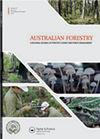Efficacy of cuprous oxide for control of dothistroma needle blight in Pinus radiata plantations in Australia
IF 0.9
4区 农林科学
Q3 FORESTRY
引用次数: 1
Abstract
ABSTRACT Dothistroma needle blight (DNB, Dothistroma septosporum) is a significant disease in Pinus radiata plantations on the Northern Tablelands of New South Wales and in the Murray Valley region of Victoria/New South Wales, Australia. Aerial application of copper oxychloride has been used to control DNB in these regions since soon after it was established. Research in New Zealand, however, has identified cuprous oxide as a more efficient and cheaper fungicide for controlling DNB. In this study, we test the efficacy of a single (applied in late October–early November) and double (October and February) application of cuprous oxide for controlling severe ( 50%) DNB in P. radiata plantations on the Northern Tablelands. We established replicated blocks 5–10 ha in size to ensure the results were operationally valid. Disease severity and defoliation were assessed on individual trees pre- and post-treatment, and aerial surveys were conducted to gauge the effect of treatments on the subsequent operational fungicide spray program. Cuprous oxide application significantly (P 0.01) reduced disease severity compared with no application, with a second application reducing severity even further. Ten months post-treatment, tree-level disease severity was 39% in unsprayed plots, 31% in single-sprayed plots and 8.5% in double-sprayed plots. The double application effectively reduced disease to negligible levels, while the single application provided adequate control for up to three months. At an operational level, even the single fungicide application reduced disease severity at the block scale when mapped during aerial surveys. Based on aerial assessments that trigger control action, all unsprayed plots required fungicide application in the season after the study (2013), while only two of seven single-sprayed blocks and none of the double-sprayed blocks required additional control. Extrapolating from this, a single fungicide application meant that 70% of the area did not require a fungicide application in the subsequent year. Based on these results and evidence from New Zealand, we recommend that cuprous oxide replace copper oxychloride for DNB control in Australia and that a double application is used in areas with severe ( 50%) levels of the disease.氧化亚铜防治澳大利亚辐射松人工林dothistroma针叶枯病的效果
摘要:斑点状茎枯病(DNB,Dothistroma septosporum)是澳大利亚新南威尔士州北部高原和维多利亚/新南威尔士州默里谷地区辐射松人工林中的一种重要疾病。空中施用氯氧化铜自建立后不久就被用于控制这些地区的DNB。然而,新西兰的研究表明,氧化亚铜是一种更有效、更便宜的控制DNB的杀菌剂。在这项研究中,我们测试了一次(10月下旬至11月初)和两次(10和2月)施用氧化亚铜对北部高原辐射P.radiata种植园严重(50%)DNB的控制效果。我们建立了规模为5-10公顷的复制区块,以确保结果在操作上有效。对处理前后的个别树木的疾病严重程度和落叶情况进行了评估,并进行了空中调查,以评估处理对随后的杀菌剂喷洒计划的影响。与不施用相比,施用氧化亚铜显著降低了疾病的严重程度(P 0.01),第二次施用甚至进一步降低了严重程度。治疗10个月后,未喷洒地块的树级疾病严重程度为39%,单喷地块为31%,双喷地块为8.5%。双重应用有效地将疾病降低到可以忽略的水平,而单次应用提供了长达三个月的充分控制。在操作层面上,即使是单一的杀菌剂应用,在航测期间绘制地图时,也可以在区块尺度上降低疾病的严重程度。根据引发控制行动的空中评估,所有未喷洒地块都需要在研究后的季节(2013年)施用杀菌剂,而七个单喷地块中只有两个需要额外控制,而双喷地块中没有一个需要额外的控制。由此推断,一次施用杀菌剂意味着70%的地区在接下来的一年不需要施用杀菌剂。根据这些结果和新西兰的证据,我们建议在澳大利亚用氧化亚铜代替氯氧化铜来控制DNB,并在疾病严重(50%)的地区使用双重应用。
本文章由计算机程序翻译,如有差异,请以英文原文为准。
求助全文
约1分钟内获得全文
求助全文
来源期刊

Australian Forestry
FORESTRY-
CiteScore
3.70
自引率
4.80%
发文量
15
审稿时长
>12 weeks
期刊介绍:
Australian Forestry is published by Taylor & Francis for the Institute of Foresters of Australia (IFA) for scientific, technical, and professional communication relating to forestry in the Asia Pacific.
 求助内容:
求助内容: 应助结果提醒方式:
应助结果提醒方式:


